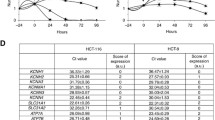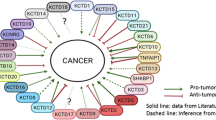Abstract
Introduction
Data suggest a role of the potassium channel SK3 (KCNN3 gene) in oxaliplatin-induced neurotoxicity (OIN). Length variations in the polymorphic CAG repeat of the KCNN3 gene may be associated with the risk of OIN.
Materials and methods
We performed patch-clamp experiments on HEK293 cell lines, expressing SK3 channel isoforms with short (11) or long (24) CAG repetitions, to measure intracellular calcium concentrations to test the effects of oxaliplatin on current density. A retrospective study was carried out on patients with colorectal cancer who had received oxaliplatin-based chemotherapy. DNA for KCNN3 genotyping was extracted from leukocytes. The region containing the CAG repeats was amplified by PCR and the products separated by capillary electrophoresis for length analysis. The patients were divided into three groups depending on whether they carried two short alleles, one short allele and one long allele, or two long alleles. The primary endpoint was the onset of grade 2 or 3 neuropathy to oxaliplatin.
Results
There was no difference in current density, but oxaliplatin induced a differential effect on apamin-sensitive current density between the two isoforms expressed in the HEK cell lines. There was a significant reduction of store-operated calcium entry into cells expressing the short and more active isoform only after high concentration of oxaliplatin exposition. Eighty-six patients were included in the clinical study. There was no significant association between OIN and KCNN3 polymorphism for the three groups.
Conclusion
We observed a slight association between OIN and CAG repeat polymorphisms of the KCNN3 gene in a preclinical model, but not a clinical study.






Similar content being viewed by others
References
de Gramont A, Figer A, Seymour M et al (2000) Leucovorin and fluorouracil with or without oxaliplatin as first-line treatment in advanced colorectal cancer. J Clin Oncol 18:2938–2947
Andre T, Boni C, Mounedji-Boudiaf L et al (2004) Oxaliplatin, fluorouracil, and leucovorin as adjuvant treatment for colon cancer. N Engl J Med 350:2343–2351
Gamelin L, Boisdron-Celle M, Morel A et al (2006) Oxaliplatin neurotoxicity. Bull Cancer 93(Suppl 1):S17–S22
Ta LE, Espeset L, Podratz J et al (2006) Neurotoxicity of oxaliplatin and cisplatin for dorsal root ganglion neurons correlates with platinum-DNA binding. Neurotoxicology 27:992–1002
Di Cesare Mannelli L, Pacini A, Micheli L et al (2014) Glial role in oxaliplatin-induced neuropathic pain. Exp Neurol 261:22–33
Park SB, Lin CS, Kiernan MC (2012) Nerve excitability assessment in chemotherapy-induced neurotoxicity. J Vis Exp. https://doi.org/10.3791/3439
Park SB, Lin CS-Y, Krishnan AV et al (2009) Oxaliplatin-induced neurotoxicity: changes in axonal excitability precede development of neuropathy. Brain 132:2712–2723
Grolleau F, Gamelin L, Boisdron-Celle M et al (2001) A possible explanation for a neurotoxic effect of the anticancer agent oxaliplatin on neuronal voltage-gated sodium channels. J Neurophysiol 85:2293–2297
Kagiava A, Tsingotjidou A, Emmanouilides C et al (2008) The effects of oxaliplatin, an anticancer drug, on potassium channels of the peripheral myelinated nerve fibres of the adult rat. Neurotoxicology 29:1100–1106
Sittl R, Carr RW, Fleckenstein J et al (2010) Enhancement of axonal potassium conductance reduces nerve hyperexcitability in an in vitro model of oxaliplatin-induced acute neuropathy. Neurotoxicology 31:694–700
Descoeur J, Pereira V, Pizzoccaro A et al (2011) Oxaliplatin-induced cold hypersensitivity is due to remodelling of ion channel expression in nociceptors. EMBO Mol Med 3:266–278
Benoit E, Brienza S, Dubois JM (2006) Oxaliplatin, an anticancer agent that affects both Na+ and K+ channels in frog peripheral myelinated axons. Gen Physiol Biophys 25:263–276
Wu S-N, Chen B-S, Wu Y-H et al (2009) The mechanism of the actions of oxaliplatin on ion currents and action potentials in differentiated NG108-15 neuronal cells. Neurotoxicology 30:677–685
Stocker M, Pedarzani P (2000) Differential distribution of three Ca(2+)-activated K(+) channel subunits, SK1, SK2, and SK3, in the adult rat central nervous system. Mol Cell Neurosci 15:476–493
Dilly S, Poncin S, Lamy C et al (2012) Physiology, pharmacology and modelling of potassium channels: focus on SK channels. Med Sci (Paris) 28:395–402
Chandy KG, Fantino E, Wittekindt O et al (1998) Isolation of a novel potassium channel gene hSKCa3 containing a polymorphic CAG repeat: a candidate for schizophrenia and bipolar disorder? Mol Psychiatry 3:32–37
Figueroa KP, Chan P, Schöls L et al (2001) Association of moderate polyglutamine tract expansions in the slow calcium-activated potassium channel type 3 with ataxia. Arch Neurol 58:1649–1653
Li T, Hu X, Chandy KG et al (1998) Transmission disequilibrium analysis of a triplet repeat within the hKCa3 gene using family trios with schizophrenia. Biochem Biophys Res Commun 251:662–665
Grube S, Gerchen MF, Adamcio B et al (2011) A CAG repeat polymorphism of KCNN3 predicts SK3 channel function and cognitive performance in schizophrenia. EMBO molecular medicine 3:309–319
Ritsner M, Modai I, Ziv H et al (2002) An association of CAG repeats at the KCNN3 locus with symptom dimensions of schizophrenia. Biol Psychiat 51:788–794
Mössner R, Weichselbaum A, Marziniak M et al (2005) A highly polymorphic poly-glutamine stretch in the potassium channel KCNN3 in migraine. Headache 45:132–136
Basso M, Modoni A, Spada D et al (2011) Polymorphism of CAG motif of SK3 gene is associated with acute oxaliplatin neurotoxicity. Cancer Chemother Pharmacol 67:1179–1187
Park SB, Lin CS-Y, Krishnan AV et al (2011) The contribution of SK3 polymorphisms to acute oxaliplatin-induced neurotoxicity: direct or indirect effects? Cancer Chemother Pharmacol 67:1189–1190 (author reply 91–92)
Hosseini R, Benton DC, Dunn PM et al (2001) SK3 is an important component of K(+) channels mediating the afterhyperpolarization in cultured rat SCG neurones. J Physiol 535:323–334
Potier M, Joulin V, Roger S et al (2006) Identification of SK3 channel as a new mediator of breast cancer cell migration. Mol Cancer Ther 5:2946–2953
Caussanel JP, Levi F, Brienza S et al (1990) Phase I trial of 5-day continuous venous infusion of oxaliplatin at circadian rhythm-modulated rate compared with constant rate. J Natl Cancer Inst 82:1046–1050
Lecomte T, Landi B, Beaune P et al (2006) Glutathione S-transferase P1 polymorphism (Ile105Val) predicts cumulative neuropathy in patients receiving oxaliplatin-based chemotherapy. Clin Cancer Res 12:3050–3056
Gueguinou M, Harnois T, Crottes D et al (2016) SK3/TRPC1/Orai1 complex regulates SOCE-dependent colon cancer cell migration: a novel opportunity to modulate anti-EGFR mAb action by the alkyl-lipid Ohmline. Oncotarget 7:36168–36184
Esfahani A, Somi MH, Ayromlou H et al (2016) The effect of n-3 polyunsaturated fatty acids on incidence and severity of oxaliplatin induced peripheral neuropathy: a randomized controlled trial. Biomark Res 4:13
Gamelin L, Capitain O, Morel A et al (2007) Predictive factors of oxaliplatin neurotoxicity: the involvement of the oxalate outcome pathway. Clin Cancer Res 13:6359–6368
Lopatin AN, Nichols CG (2001) Inward rectifiers in the heart: an update on I(K1). J Mol Cell Cardiol 33:625–638
Nikolaev MV, Magazanik LG, Tikhonov DB (2012) Influence of external magnesium ions on the NMDA receptor channel block by different types of organic cations. Neuropharmacology 62:2078–2085
Ferrier J, Bayet-Robert M, Pereira B et al (2013) A polyamine-deficient diet prevents oxaliplatin-induced acute cold and mechanical hypersensitivity in rats. PLoS One 8:e77828
Ngo-Anh TJ, Bloodgood BL, Lin M et al (2005) SK channels and NMDA receptors form a Ca2+-mediated feedback loop in dendritic spines. Nat Neurosci 8:642–649
Austin CPH, Ma DJL, Mixson LA, Caskey CT (1999) Mapping of hKCa3 to chromosome 1q21 and investigation of linkage of CAG repeat polymorphism to schizophrenia. Mol Psychiatry 4:261
Curtain R, Sundholm J, Lea R et al (2005) Association analysis of a highly polymorphic CAG Repeat in the human potassium channel gene KCNN3 and migraine susceptibility. BMC Med Genet 6:32
Ivković MR, Tarasjev V, Orolicki A, Damjanović S, Paunović A (2006) Schizophrenia and Polymorphic Cag Repeats Array of Calcium-Activated Potassium Channel (Kcnn3) Gene in Serbian Population. Int J Neurosci 116:157–164
Ujike H, Yamamoto A, Tanaka Y et al (2001) Association study of CAG repeats in the KCNN3 gene in Japanese patients with schizophrenia, schizoaffective disorder and bipolar disorder. Psychiatry Res 101:203–207
Sander T, Scholz L, Janz D et al (1999) Length variation of a polyglutamine array in the gene encoding a small-conductance, calcium-activated potassium channel (hKCa3) and susceptibility to idiopathic generalized epilepsy. Epilepsy Res 33:227–233
Koronyo-Hamaoui M, Gak E, Stein D et al (2004) CAG repeat polymorphism within the KCNN3 gene is a significant contributor to susceptibility to anorexia nervosa: a case-control study of female patients and several ethnic groups in the Israeli Jewish population. Am J Med Genet Part B, Neuropsychiatric Genet 131B:76–80
Saleem Q, Sreevidya VS, Sudhir J et al (2000) Association analysis of CAG repeats at the KCNN3 locus in Indian patients with bipolar disorder and schizophrenia. Am J Med Genet 96:744–748
Tuteja D, Rafizadeh S, Timofeyev V et al (2010) Cardiac small conductance Ca2+-activated K+ channel subunits form heteromultimers via the coiled-coil domains in the C termini of the channels. Circ Res 107:851–859
Acknowledgements
The authors would like to thank Network “Ion channels and cancer—Canceropôle Grand Ouest”, (IC-CGO) France (http://www.ic-cgo.fr/). Prof. Dr. Luis A. Pardo (Max-Planck-Institute of Experimental Medicine, Germany) kindly gave us HEK cells expressing long and short SK3.
Funding
A. Girault had a fellowship from the “Fondation de France”.
Author information
Authors and Affiliations
Corresponding author
Ethics declarations
Conflict of interest
All authors declare that they have no conflict of interest.
Rights and permissions
About this article
Cite this article
Anon, B., Largeau, B., Girault, A. et al. Possible association of CAG repeat polymorphism in KCNN3 encoding the potassium channel SK3 with oxaliplatin-induced neurotoxicity. Cancer Chemother Pharmacol 82, 149–157 (2018). https://doi.org/10.1007/s00280-018-3600-1
Received:
Accepted:
Published:
Issue Date:
DOI: https://doi.org/10.1007/s00280-018-3600-1




